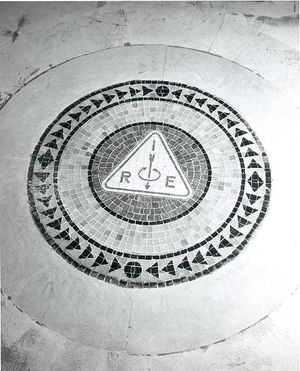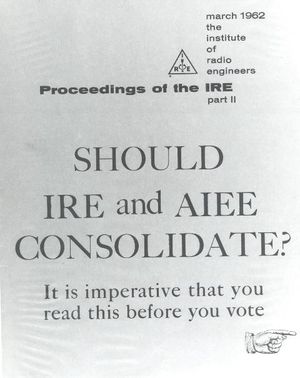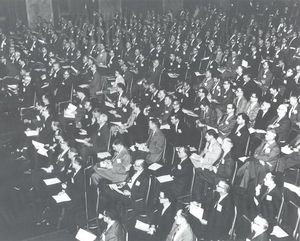IEEE History: Difference between revisions
mNo edit summary |
(Added links) |
||
| Line 5: | Line 5: | ||
IEEE, an association dedicated to the fostering of technological innovation and excellence for the benefit of humanity, is the world’s largest technical professional society. It is designed to serve professionals involved in all aspects of the electrical, electronic and computing fields and related areas of science and technology that underlie modern civilization. IEEE’s roots, however, go back to 1884 when electricity was just beginning to become a major force in society. There was one major established electrical industry, the [[Telegraph|telegraph]], which—beginning in the 1840s—had come to connect the world with a communications system faster than the speed of transportation. A second major area had only barely gotten underway—electric power and light, originating in [[Thomas Alva Edison|Thomas Edison]]’s inventions and his pioneering [[Pearl Street Station|Pearl Street Station]] in New York. | IEEE, an association dedicated to the fostering of technological innovation and excellence for the benefit of humanity, is the world’s largest technical professional society. It is designed to serve professionals involved in all aspects of the electrical, electronic and computing fields and related areas of science and technology that underlie modern civilization. IEEE’s roots, however, go back to 1884 when electricity was just beginning to become a major force in society. There was one major established electrical industry, the [[Telegraph|telegraph]], which—beginning in the 1840s—had come to connect the world with a communications system faster than the speed of transportation. A second major area had only barely gotten underway—electric power and light, originating in [[Thomas Alva Edison|Thomas Edison]]’s inventions and his pioneering [[Pearl Street Station|Pearl Street Station]] in New York. | ||
=== Foundation of the AIEE === | === [[AIEE_History_1884-1963|Foundation of the AIEE]] === | ||
[[Image:AIEE Badge 0874.jpg|thumb|right]]In the spring of 1884, a small group of individuals in the electrical professions met in New York. They formed a new organization to support professionals in their nascent field and to aid them in their efforts—the American Institute of Electrical Engineers, or AIEE for short. That October the AIEE held its first technical meeting in Philadelphia. Many early leaders, such as founding President Norvin Green of [[Western Union|Western Union]], came from telegraphy. Others, such as Thomas Edison, came from power, while [[Alexander Graham Bell|Alexander Graham Bell]] represented the newer telephone industry. As electric power spread rapidly across the land—enhanced by innovations such as [[Nikola Tesla|Nikola Tesla’s]] AC Induction Motor, long distance AC transmission and large-scale power plants, and commercialized by industries such as Westinghouse and [[General Electric (GE)|General Electric]]—the AIEE became increasingly focused on electrical power and its ability to change people’s lives through the unprecedented products and services it could deliver. There was a secondary focus on wired communication, both the telegraph and the telephone. Through technical meetings, publications, and promotion of standards, the AIEE led the growth of the electrical engineering profession, while through local sections and student branches, it brought its benefits to engineers in widespread places. | [[Image:AIEE Badge 0874.jpg|thumb|right]]In the spring of 1884, a small group of individuals in the electrical professions met in New York. They formed a new organization to support professionals in their nascent field and to aid them in their efforts—the American Institute of Electrical Engineers, or AIEE for short. That October the AIEE held its first technical meeting in Philadelphia. Many early leaders, such as founding President Norvin Green of [[Western Union|Western Union]], came from telegraphy. Others, such as Thomas Edison, came from power, while [[Alexander Graham Bell|Alexander Graham Bell]] represented the newer telephone industry. As electric power spread rapidly across the land—enhanced by innovations such as [[Nikola Tesla|Nikola Tesla’s]] AC Induction Motor, long distance AC transmission and large-scale power plants, and commercialized by industries such as Westinghouse and [[General Electric (GE)|General Electric]]—the AIEE became increasingly focused on electrical power and its ability to change people’s lives through the unprecedented products and services it could deliver. There was a secondary focus on wired communication, both the telegraph and the telephone. Through technical meetings, publications, and promotion of standards, the AIEE led the growth of the electrical engineering profession, while through local sections and student branches, it brought its benefits to engineers in widespread places. | ||
| Line 17: | Line 17: | ||
<br> | <br> | ||
=== Foundation of the IRE | === [[IRE_History_1912-1963|Foundation of the IRE]] === | ||
[[Image:Brokaw mansion mosaic 0970(10).jpg|thumb|right|IRE Mosaic in the Society's Brokaw Mansion]]A new industry arose beginning with [[Guglielmo Marconi|Guglielmo Marconi]]’s wireless telegraphy experiments at the turn of the century. What was originally called “wireless” became radio with the electrical amplification possibilities inherent in the vacuum tubes which evolved from John Fleming’s diode and [[Lee De Forest|Lee de Forest]]’s triode. With the new industry came a new society in 1912, the Institute of Radio Engineers. The [[Image:IRE Proceedings on Merger 1637.jpg|thumb|right]]IRE was modeled on the AIEE, but was devoted to radio, and then increasingly to electronics. It, too, furthered its profession by linking its members through publications, standards and conferences, and encouraging them to advance their industries by promoting innovation and excellence in the emerging new products and services.<br> | [[Image:Brokaw mansion mosaic 0970(10).jpg|thumb|right|IRE Mosaic in the Society's Brokaw Mansion]]A new industry arose beginning with [[Guglielmo Marconi|Guglielmo Marconi]]’s wireless telegraphy experiments at the turn of the century. What was originally called “wireless” became radio with the electrical amplification possibilities inherent in the vacuum tubes which evolved from John Fleming’s diode and [[Lee De Forest|Lee de Forest]]’s triode. With the new industry came a new society in 1912, the Institute of Radio Engineers. The [[Image:IRE Proceedings on Merger 1637.jpg|thumb|right]]IRE was modeled on the AIEE, but was devoted to radio, and then increasingly to electronics. It, too, furthered its profession by linking its members through publications, standards and conferences, and encouraging them to advance their industries by promoting innovation and excellence in the emerging new products and services.<br> | ||
| Line 35: | Line 35: | ||
<br> | <br> | ||
=== The Societies Converge and Merge | === [[Formation_of_IEEE_by_the_Merger_of_AIEE_and_IRE|The Societies Converge and Merge]] === | ||
[[Image:Merger Symposium 0975.jpg|thumb|right|Merger Symposium at 1962 IRE Convention]]Through the help of leadership from the two societies, and with the applications of its members’ innovations to industry, electricity wove its way—decade by decade—more deeply into every corner of life—television, radar, transistors, computers. Increasingly, the interests of the societies overlapped. Membership in both societies grew, but beginning in the 1940s, the IRE grew faster and in 1957 became the larger group. On 1 January 1 1963, The AIEE and the IRE [[Merger Documents|merged to]] form the Institute of Electrical and Electronics Engineers, or IEEE. At its formation, the IEEE had 150,000 members, 140,000 of whom were in the United States. | [[Image:Merger Symposium 0975.jpg|thumb|right|Merger Symposium at 1962 IRE Convention]]Through the help of leadership from the two societies, and with the applications of its members’ innovations to industry, electricity wove its way—decade by decade—more deeply into every corner of life—television, radar, transistors, computers. Increasingly, the interests of the societies overlapped. Membership in both societies grew, but beginning in the 1940s, the IRE grew faster and in 1957 became the larger group. On 1 January 1 1963, The AIEE and the IRE [[Merger Documents|merged to]] form the Institute of Electrical and Electronics Engineers, or IEEE. At its formation, the IEEE had 150,000 members, 140,000 of whom were in the United States. | ||
| Line 51: | Line 51: | ||
<br> | <br> | ||
=== | === [[IEEE_1963-1984|IEEE 1963-1984]]<br> === | ||
Over the decades that followed, with IEEE’s continued leadership, the societal roles of the technologies under its aegis continued to spread across the world, and reach into more and more areas of people’s lives. The professional groups and technical boards of the predecessor institutions evolved into IEEE Societies. By the | Over the decades that followed, with IEEE’s continued leadership, the societal roles of the technologies under its aegis continued to spread across the world, and reach into more and more areas of people’s lives. The professional groups and technical boards of the predecessor institutions evolved into IEEE Societies. By the time IEEE celebrated its centennial (from the year AIEE was formed) in 1984, it had 250,000 members, 50,000 of whom were outside the United States. <br> | ||
Since that time, computers evolved from massive mainframes to desktop appliances to portable devices, all part of a global network connected by [[Communications Satellites|satellites]] and then by [[Fiber Optics|fiber optics]]. IEEE’s fields of interest expanded well beyond electrical/electronic engineering and computing into areas such as [[Early Microelectronics|micro]]- and [[Building Blocks of Nanotechology|nanotechnology]], ultrasonics, bioengineering, robotics, electronic materials, and many others. Electronics became ubiquitous—from jet cockpits to industrial robots to medical imaging. As technologies and the industries that developed them increasingly transcended national boundaries, IEEE kept pace, becoming a truly global institution which used the innovations of the practitioners it represented in order to enhance its own excellence in delivering products and services to members, industries, and the public at large. Publications and educational programs were delivered online, as were member services such as renewal and elections. By | === [[IEEE_1984_to_the_Present|IEEE from 1984]]<br> === | ||
Since that time, computers evolved from massive mainframes to desktop appliances to portable devices, all part of a global network connected by [[Communications Satellites|satellites]] and then by [[Fiber Optics|fiber optics]]. IEEE’s fields of interest expanded well beyond electrical/electronic engineering and computing into areas such as [[Early Microelectronics|micro]]- and [[Building Blocks of Nanotechology|nanotechnology]], ultrasonics, bioengineering, robotics, electronic materials, and many others. Electronics became ubiquitous—from jet cockpits to industrial robots to medical imaging. As technologies and the industries that developed them increasingly transcended national boundaries, IEEE kept pace, becoming a truly global institution which used the innovations of the practitioners it represented in order to enhance its own excellence in delivering products and services to members, industries, and the public at large. | |||
By the early 21st Century, IEEE served its members and their interests with 38 societies; 130 journals, transactions and magazines; more 300 conferences annually; and 900 active standards.<br> | |||
Publications and educational programs were delivered online, as were member services such as renewal and elections. By 2009, IEEE had 380,000 members in 160 countries, with 44.5 percent outside of the country where it was founded a century and a quarter before. Through its worldwide network of geographical units, publications, web services, and conferences, IEEE remains the world's leading professional association for the advancement of technology. | |||
[[Category:IEEE]] [[Category:History_&_heritage|Category:History_&_heritage]] | [[Category:IEEE]] [[Category:History_&_heritage|Category:History_&_heritage]] | ||
Revision as of 19:52, 24 August 2009
A Brief History of IEEE
Origins
IEEE, an association dedicated to the fostering of technological innovation and excellence for the benefit of humanity, is the world’s largest technical professional society. It is designed to serve professionals involved in all aspects of the electrical, electronic and computing fields and related areas of science and technology that underlie modern civilization. IEEE’s roots, however, go back to 1884 when electricity was just beginning to become a major force in society. There was one major established electrical industry, the telegraph, which—beginning in the 1840s—had come to connect the world with a communications system faster than the speed of transportation. A second major area had only barely gotten underway—electric power and light, originating in Thomas Edison’s inventions and his pioneering Pearl Street Station in New York.
Foundation of the AIEE
In the spring of 1884, a small group of individuals in the electrical professions met in New York. They formed a new organization to support professionals in their nascent field and to aid them in their efforts—the American Institute of Electrical Engineers, or AIEE for short. That October the AIEE held its first technical meeting in Philadelphia. Many early leaders, such as founding President Norvin Green of Western Union, came from telegraphy. Others, such as Thomas Edison, came from power, while Alexander Graham Bell represented the newer telephone industry. As electric power spread rapidly across the land—enhanced by innovations such as Nikola Tesla’s AC Induction Motor, long distance AC transmission and large-scale power plants, and commercialized by industries such as Westinghouse and General Electric—the AIEE became increasingly focused on electrical power and its ability to change people’s lives through the unprecedented products and services it could deliver. There was a secondary focus on wired communication, both the telegraph and the telephone. Through technical meetings, publications, and promotion of standards, the AIEE led the growth of the electrical engineering profession, while through local sections and student branches, it brought its benefits to engineers in widespread places.
Foundation of the IRE
A new industry arose beginning with Guglielmo Marconi’s wireless telegraphy experiments at the turn of the century. What was originally called “wireless” became radio with the electrical amplification possibilities inherent in the vacuum tubes which evolved from John Fleming’s diode and Lee de Forest’s triode. With the new industry came a new society in 1912, the Institute of Radio Engineers. The
IRE was modeled on the AIEE, but was devoted to radio, and then increasingly to electronics. It, too, furthered its profession by linking its members through publications, standards and conferences, and encouraging them to advance their industries by promoting innovation and excellence in the emerging new products and services.
The Societies Converge and Merge
Through the help of leadership from the two societies, and with the applications of its members’ innovations to industry, electricity wove its way—decade by decade—more deeply into every corner of life—television, radar, transistors, computers. Increasingly, the interests of the societies overlapped. Membership in both societies grew, but beginning in the 1940s, the IRE grew faster and in 1957 became the larger group. On 1 January 1 1963, The AIEE and the IRE merged to form the Institute of Electrical and Electronics Engineers, or IEEE. At its formation, the IEEE had 150,000 members, 140,000 of whom were in the United States.
IEEE 1963-1984
Over the decades that followed, with IEEE’s continued leadership, the societal roles of the technologies under its aegis continued to spread across the world, and reach into more and more areas of people’s lives. The professional groups and technical boards of the predecessor institutions evolved into IEEE Societies. By the time IEEE celebrated its centennial (from the year AIEE was formed) in 1984, it had 250,000 members, 50,000 of whom were outside the United States.
IEEE from 1984
Since that time, computers evolved from massive mainframes to desktop appliances to portable devices, all part of a global network connected by satellites and then by fiber optics. IEEE’s fields of interest expanded well beyond electrical/electronic engineering and computing into areas such as micro- and nanotechnology, ultrasonics, bioengineering, robotics, electronic materials, and many others. Electronics became ubiquitous—from jet cockpits to industrial robots to medical imaging. As technologies and the industries that developed them increasingly transcended national boundaries, IEEE kept pace, becoming a truly global institution which used the innovations of the practitioners it represented in order to enhance its own excellence in delivering products and services to members, industries, and the public at large.
By the early 21st Century, IEEE served its members and their interests with 38 societies; 130 journals, transactions and magazines; more 300 conferences annually; and 900 active standards.
Publications and educational programs were delivered online, as were member services such as renewal and elections. By 2009, IEEE had 380,000 members in 160 countries, with 44.5 percent outside of the country where it was founded a century and a quarter before. Through its worldwide network of geographical units, publications, web services, and conferences, IEEE remains the world's leading professional association for the advancement of technology.


